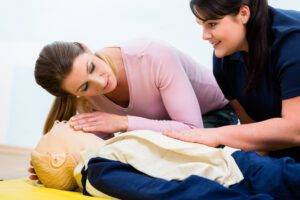
Emergencies are always lurking around, hitting us when we least expect them to. In the first few moments of such emergencies, a first aider’s correct response may save lives.
We have all heard of first aid courses and how they can greatly impact and improve our lives but what does a first aider really do? Let’s get into the depths of the responsibilities of a first aider.
Immediate response and assessment
The first and foremost role of a first aider in an emergency is to provide immediate assistance to those in need. Whether the first aider is already at the scene or arrives shortly after, the first aider needs to quickly assess the situation to understand the nature and severity of the medical conditions or injuries if there are any, without creating a panic. This initial assessment is crucial not only in terms of giving first aid but also helps the first responders, or the medical staff to quickly get into the treatment of the patient, saving precious time. It also ensures that the most urgent cases are tended to first.
Administering First Aid
Once the first aider has assessed the situation properly, they proceed to administer the necessary first aid. This can range from dressing up a bleeding wound, performing CPR, Heimlich maneuver, or providing relief to someone experiencing a severe allergic reaction. Their training equips them with the correct knowledge and skills to provide the care they can until professional help arrives, all the while staying calm.
Maintaining Calm and Reassuring the affected individuals
Emergencies are often paired with chaos which leads to panic. As a first aider, it’s one of their biggest responsibilities to maintain a calm demeanor and also reassure those who are affected. Being calm, and sharing comforting words can make a huge difference, as it can help alleviate fear and anxiety. It can also help the affected individual feel safe, keeping their heart rate and breathing normal. If a person doesn’t feel safe they’ll go into panic mode which can worsen their condition.
Communicating with Emergency services
First aider is trained to provide immediate care but they also recognize the importance of professional medical assistance. So when a first aider can remain calm, assess the situation properly, and share it with emergency services, they can give essential details about the condition of the affected individuals which can greatly impact how fast they get treated. For example, if you are providing first aid to a burn victim, you’d communicate it with emergency services who will then make room for the patient to be in the burn care unit and they’d come equipped with the right materials saving time and potentially saving a life.
Monitoring and Observing
This comes after administering first aid; while you wait for the medical assistance to arrive, you need to continuously monitor the affected individuals, observing any changes or complications. Their continuous vigilance ensures that any decline in the condition of a person needs additional assistance. If a burn patient is being treated for their burns while the first aider waits for medical staff, the first aider must keep a close eye on the person so they don’t lose consciousness or stop breathing.
Educating and Promoting Safety Awareness
First aiders do so much more than helping injured individuals when they provide first aid in a situation. Unintentionally they end up spreading awareness about how important first aid is, encouraging people to go for training. First aiders spread awareness through proper channels too, they have workshops, training sessions, and community outreach programs to provide the public with the knowledge they need and how a first aider should respond in situations.
Conclusion
The role of a first aider during an emergency is intricate, multifaceted, and indispensable. Their quick response, expert knowledge, communication skills, and ability to stay calm are a few of the top qualities of a first aider. These skills end up saving lives and make them out to be unsung heroes in our communities. As we navigate through the uncertainties of life, it’s good to know that there are people who are dedicated to caring for others, which restores my faith in humanity.
Read more:
The Crucial Role of a First Aider During an Emergency




